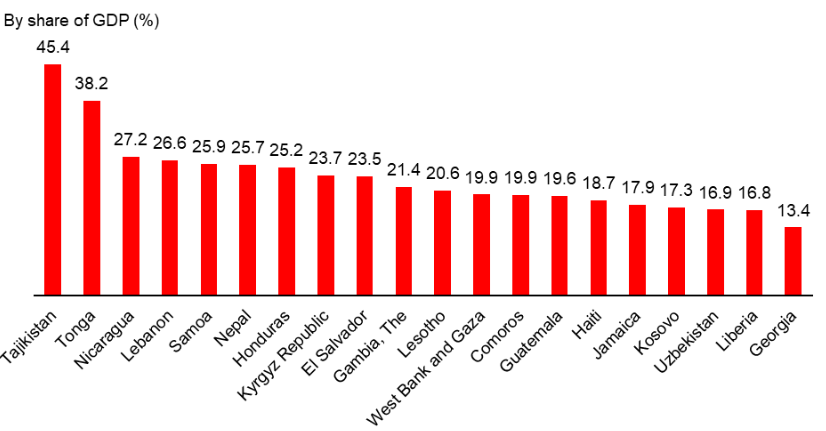Remittances to LMICs are expected to reach $685bn

By MG News | December 23, 2024 at 12:00 PM GMT+05:00
December 23, 2024 (MLN): Remittances to low- and middle-income countries (LMICs) are expected to reach an impressive $685 billion in 2024, signaling a significant recovery and growth in international money transfers, according to the latest blog by the World Bank.
This marks a substantial improvement in the growth rate, which is forecasted at 5.8% for the year, compared to a modest 1.2% increase in 2023.
The top five recipient countries for remittances in 2024 are India, with an estimated inflow of $129bn, followed by Mexico ($68bn), China ($48bn), the Philippines ($40bn), and Pakistan ($33bn).
In smaller economies, remittance inflows represent very large shares of gross domestic product (GDP), highlighting the importance of remittances for funding the current account and fiscal shortfalls.
Topping the list is Tajikistan (45% of GDP), followed by Tonga (38%), Nicaragua (27%), Lebanon (27%), and Samoa (26%), the graph shows as,
Top Recipients:
The recovery of the job markets in the high-income countries of the Organization for Economic Co-operation and Development (OECD), following the onset of the COVID-19 pandemic, has been the key driver of remittances.
This is especially true for the United States where the employment of foreign-born workers has recovered steadily and is 11% higher than the pre-pandemic level seen in February 2020.
By contrast, the employment level of native-born workers has recovered to the same level as before the pandemic.
A similar pattern is seen in the case of Hispanic workers, which is a key factor for the strength of remittance flows to Latin America and the Caribbean region.
By region, remittance flows to South Asia are expected to register the highest increase in 2024, at 11.8% driven mainly by continued strong flows to India, Pakistan, and Bangladesh.
Remittances to the Middle East and Africa are estimated to have increased by 5.4%, primarily due to rebounded flows to Egypt, compared with a 14.6% decline in 2023.
In other regions, remittance growth to Latin America and the Caribbean is projected to slow to 5.5% in 2024, from 7.5% a year ago.
Remittances to Mexico are expected to reach about $68bn in 2024, an increase of 3%.
Mexico receives the most remittances in the region by far and is the world’s second-largest recipient of remittances.
Guatemala is the second-largest recipient of remittances in the LAC region.
Besides the strong job market in the United States, remittances will continue to flow to Mexico and Guatemala in part due to the considerable number of transit migrants passing through these countries (notably from Cuba, China, Ecuador, Haiti, India, Nicaragua, and Venezuela, according to data from the US Customs, Border and Protection).
Border Patrol apprehended fewer migrants at the border in November 2024 than any month since July 2020 while the number of migrants at the Southern border of Mexico seems to be increasing.
Remittances to Europe and Central Asia are also expected to increase by 3%, bouncing back from an 8.7% decline last year.
Normalization of remittance flows to Central Asian countries mostly from Russia has offset the lingering weakness in flows to Ukraine.
Growth in remittance flows in 2024 is estimated at 3.3% for East Asia and the Pacific (excluding China) and 2.4% for Sub-Saharan Africa.
Notably, remittances have continued to outpace other types of external financial flows to low- and middle-income countries.
Remittances have even surpassed FDI significantly.
The gap between remittances and FDI is expected to widen further in 2024.
During the past decade, remittances increased by 57%, while FDI declined by 41%.
Remittances will likely continue to increase because of enormous migration pressures driven by demographic trends, income gaps, and climate change.
Therefore, countries need to take note of the size and resilience of remittances and find ways to leverage these flows for poverty reduction, financing health, and education, financial inclusion of households, and improving access to capital markets for state and nonstate enterprises.
Copyright Mettis Link News
Related News
| Name | Price/Vol | %Chg/NChg |
|---|---|---|
| KSE100 | 132,561.65 90.91M |
-0.63% -841.54 |
| ALLSHR | 82,927.28 497.89M |
-0.31% -260.78 |
| KSE30 | 40,328.39 32.65M |
-0.79% -323.07 |
| KMI30 | 190,658.13 36.90M |
-0.74% -1425.79 |
| KMIALLSHR | 55,667.26 255.17M |
-0.32% -180.44 |
| BKTi | 36,172.36 5.66M |
-0.69% -250.51 |
| OGTi | 28,199.62 7.02M |
-0.84% -237.99 |
| Symbol | Bid/Ask | High/Low |
|---|
| Name | Last | High/Low | Chg/%Chg |
|---|---|---|---|
| BITCOIN FUTURES | 109,065.00 | 109,545.00 108,625.00 |
-150.00 -0.14% |
| BRENT CRUDE | 69.97 | 70.09 69.85 |
-0.18 -0.26% |
| RICHARDS BAY COAL MONTHLY | 97.50 | 0.00 0.00 |
2.05 2.15% |
| ROTTERDAM COAL MONTHLY | 106.65 | 106.65 106.25 |
0.50 0.47% |
| USD RBD PALM OLEIN | 998.50 | 998.50 998.50 |
0.00 0.00% |
| CRUDE OIL - WTI | 68.14 | 68.27 67.78 |
-0.19 -0.28% |
| SUGAR #11 WORLD | 16.15 | 16.37 16.10 |
-0.13 -0.80% |
Chart of the Day
Latest News
Top 5 things to watch in this week
Pakistan Stock Movers
| Name | Last | Chg/%Chg |
|---|
| Name | Last | Chg/%Chg |
|---|


.jpeg)
.png)
